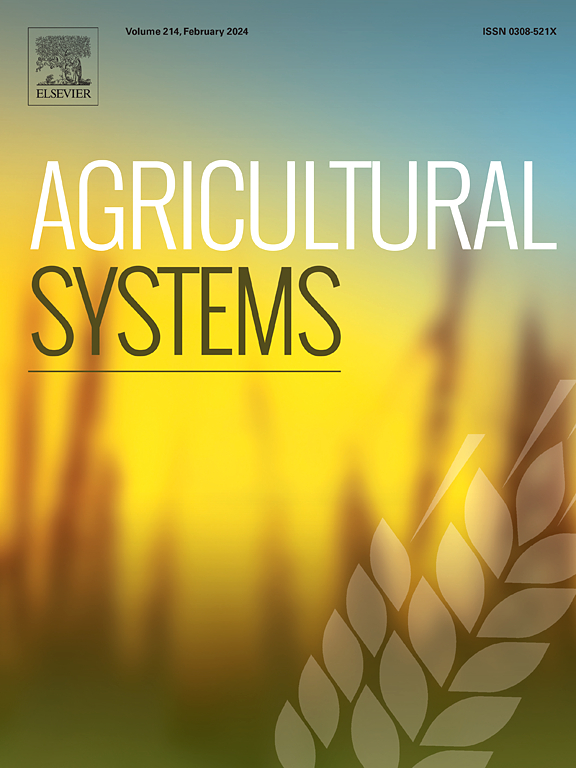Assessing Saskatchewan forage production with regard to carbon and nitrogen emissions
IF 6.1
1区 农林科学
Q1 AGRICULTURE, MULTIDISCIPLINARY
引用次数: 0
Abstract
CONTEXT
Policy issues in most nations include adapting primary agricultural production to reduce greenhouse gas (GHG) emissions. Commitments have been established through multi-lateral agreements targeting GHG emission reductions to abate climate change impacts. In response to policy initiatives targeted at industries such as agriculture, producers are adopting innovative production methods and technologies to provide environmental services and mitigate emissions. GHG emissions arising from livestock production contribute to a damaging narrative surrounding agriculture, particularly beef production.
OBJECTIVE
The purpose of this study is three-fold, quantifying (a) net emissions,2 (b) changes in practice, and (c) economic outcomes attributed to the forage production facet of cow-calf production.
METHODS
The Saskatchewan Forage Production Survey was developed to gather forage management practices data, placing emphasis on land use and land management changes. Canada's whole-farm assessment model, Holos, was applied as a carbon accounting framework to derive the net emissions of the forage production cycle.
RESULTS AND CONCLUSIONS
Results indicate carbon sequestration increased between the periods of 1991–94 and 2016–19. Gross emissions decreased to a larger degree and net emission results for the forage production facet of the Saskatchewan cow calf sector are −0.123 Mg CO2e/ha/yr in 2016–19.
SIGNIFICANCE
Recommendations include the renewal of forage rejuvenation funding programs that may improve forage yields and carbon sequestration potential. Further, the expansion of term conservation easement programs to include non-native forage lands is recommended to incentivize the retention of forage land.

评估萨斯喀彻温省饲料生产的碳和氮排放
大多数国家的政策问题包括调整初级农业生产以减少温室气体(GHG)排放。通过旨在减少温室气体排放以减轻气候变化影响的多边协定,已作出承诺。为了响应针对农业等行业的政策倡议,生产商正在采用创新的生产方法和技术来提供环境服务和减少排放。畜牧业生产产生的温室气体排放助长了围绕农业,特别是牛肉生产的破坏性叙述。本研究的目的有三个方面,量化(a)净排放,2 (b)实践变化,以及(c)奶牛犊牛生产中饲料生产方面的经济成果。方法开展萨斯喀彻温省牧草生产调查,收集牧草管理实践数据,重点关注土地利用和土地管理变化。加拿大的全农场评估模型Holos被用作碳核算框架,以得出饲料生产周期的净排放量。结果与结论结果表明,1991 - 1994年和2016 - 2019年期间碳固存有所增加。2016-19年,萨斯喀彻温省奶牛犊牛部门的饲料生产方面的总排放量下降幅度更大,净排放量为- 0.123 Mg CO2e/ha/年。重要的建议包括草料再生资助计划的更新,这可能会提高草料产量和碳封存潜力。此外,建议扩大长期保护地役权计划,包括非本地牧草用地,以激励牧草用地的保留。
本文章由计算机程序翻译,如有差异,请以英文原文为准。
求助全文
约1分钟内获得全文
求助全文
来源期刊

Agricultural Systems
农林科学-农业综合
CiteScore
13.30
自引率
7.60%
发文量
174
审稿时长
30 days
期刊介绍:
Agricultural Systems is an international journal that deals with interactions - among the components of agricultural systems, among hierarchical levels of agricultural systems, between agricultural and other land use systems, and between agricultural systems and their natural, social and economic environments.
The scope includes the development and application of systems analysis methodologies in the following areas:
Systems approaches in the sustainable intensification of agriculture; pathways for sustainable intensification; crop-livestock integration; farm-level resource allocation; quantification of benefits and trade-offs at farm to landscape levels; integrative, participatory and dynamic modelling approaches for qualitative and quantitative assessments of agricultural systems and decision making;
The interactions between agricultural and non-agricultural landscapes; the multiple services of agricultural systems; food security and the environment;
Global change and adaptation science; transformational adaptations as driven by changes in climate, policy, values and attitudes influencing the design of farming systems;
Development and application of farming systems design tools and methods for impact, scenario and case study analysis; managing the complexities of dynamic agricultural systems; innovation systems and multi stakeholder arrangements that support or promote change and (or) inform policy decisions.
 求助内容:
求助内容: 应助结果提醒方式:
应助结果提醒方式:


